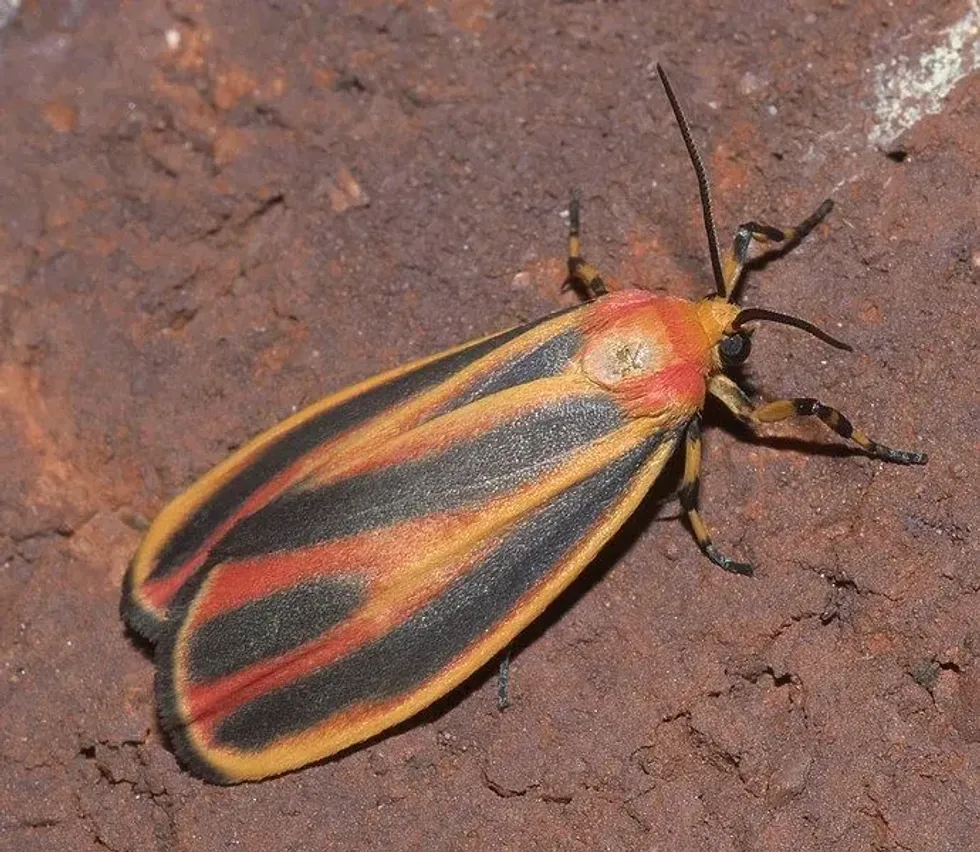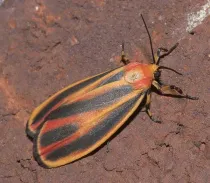Painted Lichen Moth belongs to the family Erebidae and genus Hypoprepia and the order Lepidoptera and subfamily Arctiinae. This moth insect is found in the United States and Canada.
This moth can be spotted near or in the woods and forests.
It is known that the adult of these species flies from May to September and during the caterpillar stage, these species tend to overwinter and if they survive the winter, they pupate. These moths are known to be orange or red and black and the larvae or caterpillar is known to be different than the adult, they are brown.
These are known to be quite similar to their relative Scarlet-Winged Lichen Moth (Hypoprepia Miniata).
The larvae or the caterpillars feed on or their food consists of algae, mosses, and lichen on the trees. These lichens are not edible because of the chemicals present in their bodies due to the bright colors while the tiger moths of the same family and order are edible.
This insect is known to have a special hearing ability and can produce high-frequency noise which is known to be used for communication.
Adult moths are known to very well escape the predators and one of the most popular predators of these insects is bats. The young ones or the larva can sometimes be the food of other lichen moths.
It is interesting to know about these moths and if you are interested, read about Gypsy Moth facts and Puss Moth facts.
Painted Lichen Moth Interesting Facts
What type of animal is a Painted Lichen Moth?
The painted Lichen Moth is a moth.
What class of animal does a Painted Lichen Moth belong to?
The painted Lichen Moth, Hypoprepia Fucosa, belongs to the class of Insecta.
How many Painted Lichen Moths are there in the world?
There is no specific number or exact count of these moths recorded in the world.
Where does a Painted Lichen Moth live?
Lichen Moths are found in or the range of these insects including the United States and southern part of Canada in parts of the Rocky Mountains.
What is a Painted Lichen Moth's habitat?
Lichen Moths inhabit areas in the woods and near forests and similar types of habitats.
Who does Painted Lichen Moth live with?
Lichen Moths are known to be solitary.
How long does a Painted Lichen Moth live?
The lifespan of Lichen Moths is unknown.
How do they reproduce?
Not much information is available regarding the reproduction of these Lichen Moths but it is believed that the adult flies from May to September and it is known that these species, when in the caterpillar stage tend to overwinter and if they survive in the winter, then they pupate in the spring.
What is their conservation status?
The conservation status of the Painted Lichen Moth (Hypoprepia fucosa) is Least Concern.
Painted Lichen Moth Fun Facts
What does Painted Lichen Moth look like?

Painted Lichen Moths are orange and black. The forewings of the adult are red-orange and have dark-gray stripes. Every forewing has three gray stripes.
One on the leading edge, the other on the inner edge, and the last one on the outer edge. Around the head, the orange color becomes a sort of yellowish. Hindwings are known to be pinkish and have a broad dark-colored band on the outer edge.
Painted Lichen Moth larvae do not look like adults. They are known to be brown with yellow speckles or markings and they also have black-colored nodules with spiny hair.
These are known to look similar to the lightning bugs and their relative Scarlet-winged Lichen Moth (Hypoprepia miniata).
The color of the adult moths is quite alarming to predators.
How cute are they?
These moths are not considered cute.
How do they communicate?
These moths are known to have their hearing organs on the thorax and they are known to have a special ability to hear and can also produce high-frequency sounds which help them communicate for mating and also to warn the predator off. The females of the species are known to emit or produce pheromones to attract males or mates.
How big is a Painted Lichen Moth?
The exact size of these moths is unknown but is known to be small.
How fast can a Painted Lichen Moth move?
These moths are known to fly at an average speed of 33.5 mph (54 kph).
How much does a Painted Lichen Moth weigh?
The weight of these moths is unknown.
What are the male and female names of the species?
There are no specific names for the males and females of this species.
What would you call a baby Painted Lichen Moth?
A baby of Painted Lichen Moths is referred to as a caterpillar or a larva.
What do they eat?
Larvae are known to feed on lichens, which are plant-like outgrowths that develop or grow on trees and plants. The Painted Lichen moth caterpillar or larvae are also known to feed on mosses and algae too.
Are they poisonous?
While not much information is available about these moths, it is believed that these moths are toxic to some level.
Would they make a good pet?
Not much information is available regarding these moths as pets.
Did you know...
Jacob Hubner was the first one to describe these lichen moth species in 1831.
This insect belongs to the subfamily Arctiinae.
The wingspan of these moths is around 0.98-1.3 in (25-35 mm).
Due to the bright color in these species, it is considered to be inedible because of the chemicals in its body but some tiger moths, members of the same family Erebidae, and order Lepidoptera are considered to be edible.
The adult or caterpillars of these species are known to be breeding residents.
There are two subspecies of these lichen moths. This includes Hypoprepia Fucosa Subornata and Hypoprepia Fucosa Tricolor.
How colorful are they?
These moths are considered colorful as they are orange, black, and red with certain differences in coloration in wings and the larvae are different than the adult and are known to be brown.
How to get rid of Painted Lichen Moth Caterpillars?
To get rid of these moths, you can use sticky traps, freeze the clothes that show signs of or have moths or eggs or larvae, this will give the larvae and then wash off the clothes and wash or scrub the clothes use vinegar, use vinegar on that part where the moth was and if the moth infestation gets bigger then seek the help of a pest control agency or service.
Here at Kidadl, we have carefully created lots of interesting family-friendly animal facts for everyone to discover! For more relatable content, check out these Luna moth facts and Io moth facts.
You can even occupy yourself at home by drawing one on our painted lichen moth coloring pages.









